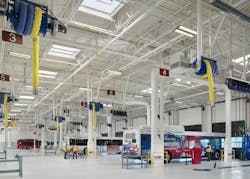As the transit industry expands to accommodate a wider range of fueling options, the infrastructure must change as well. Each fueling option has different requirements from diesel, CNG, LNG and RNG to the emerging technologies of electric, autonomous and hydrogen fuel cells. An agency must factor in the space within their fueling facilities, yards and determine what adaptions need to be made to their maintenance departments to for safety and operation.
From Diesel to CNG
Clean Energy Fuel Corp. provides services and support to modify both agencies shops and garages. Rick Mendoza, director facility modification services at Clean Energy explained that agencies need further discussion on the choice to update, construct or modify current infrastructure when housing alternative fuels as opposed to current petro fuels.
“Fuels that are really heavier than air and can puddle, when you go to an alternative fuel that is really lighter than air their shops aren’t built for that,” said Mendoza. “We go in and explain the requirements involved in the application to bringing your shop in to deal with a fuel that is lighter than air.”
Mendoza added, “We also let them know the practicality of those components and how to implement them on a cost savings basis. There is a tendency because of the lack of knowledge in the industry, if they go directly to an engineering firm and ask them to modify their shop there is the tendency for that engineering firm to overdesign. We really go in there and use their existing infrastructure and reduce costs and give them a safe and reliable system.”
“The program is called the FIT service program, which is facility testing and inspection program to benefit the industry to go out there and provide periodic maintenance. The actual manufacturers of the equipment like you to go out there and inspect it every six months and provide recalibration of the gas centers. At that time we also like to do a full functional test. If a gas plume is detected you turn on exhaust fans and either roll up the garage door to let the air floor in. Also having alarms. That’s the full function of the system. Detects, distracts, dilutes and notifies the staff locally. We don’t see enough of that happening in the industry,” said Mendoza.
“What I say is that we have seen a material amount of transit fleets move towards compressed natural gas for fueling infrastructure in the last ten years. As we continue to see that I would point to the most recent opportunities that Trillium has been doing,” said Bill Cashmareck, managing director for Trillium.
Cashmareck said that agencies need to take on the perspective that one size doesn’t fit all.
Cashmareck explained that Trillium worked to implement fueling infrastructure for VIA. “If you look at VIA who is fueling hundreds of buses at one depot that takes a higher investment in infrastructure. We would customize the infrastructure to fit their needs to make sure that they are using their funds appropriately and responsibility.”
Encompassing Electric Vehicles
The San Joaquin Regional Transportation District (RTD) was awarded a pilot program with PG&E to study the agency’s Regional Transportation Center in east Stockton to handle the installation of depot chargers and infrastructure.
This is the second time RTD is venturing into electric vehicles. RTD debuted the first electric BRT route in 2017 as part of a pilot program with Proterra.
“Electric vehicles are the wave of the future,” said Darla Smith, facilities manager, RTD. “Proterra came to us and said ‘we would like us to be their pilot and we will pay for the transformer infrastructure and all of the parts and pieces to have you test out two buses that we will also give to you’. We were very excited to be a part of a pilot and being energy efficient, it was a win-win all the way around.”
The agency did not need to construct an entire new facility, rather they adapted theirs.
“We did have to put in a new transformer to accommodate the power needs, there was underground trenching that needed to be done to accommodate the wiring. We weren’t able to use our existing canopies to hold the overhead chargers,” said Smith. “Next to our building there was a transformer, we tunneled under two loading drive aisles to put in the conduit for the overhead charger and beyond that we put in the aboveground compressor brain which is how the charger works.”
Once installing the chargers and transformers Smith said that RTD didn’t need to install anything additional within their facility.
The current pilot program with PG&E the existing site already has the utility easements in place.
“PG&E will put in the trench they will put in new transformers and they will stub up the diesel chargers and we will have the diesel chargers placed over the stubs. Infrastructure wise it is all very minimal, it’s all underground, its conduit wire and that is all being handle by PG&E,” said Smith. “At the time that the depot chargers are placed the cost is that we will purchase the diesel chargers and then reimbursed by PG&E.”
Smith said that the basic costs will just be the cost of bringing in an electrician.
“We plan to get five depot chargers, we have the land and the area available, it is currently where we park our electric buses,” Smith concluded. “For us it appears that it will be pretty seamless.”
A Future Capturing Hydrogen
The Champaign-Urbana Mass Transit District (CUMTD) was awarded a $1.45 million competitive Federal Transit Administration (FTA) grant for the purchase of no-emission hydrogen fuel cell electric buses and the infrastructure to go alongside the buses. The grant was awarded in September 2017, and once completed CUMTD will be the first agency in the state of Illinois to add fuel cell electric buses to their fleet.
“We are in the planning phase; planning for the buses, the facility modifications and the infrastructure. We know that we won’t have to expand the facilities, but we will make modifications,” said Jane Sullivan, grant manager & sustainability planner, CUMTD.
Sullivan says that CUMTD has planned to order two 60-foot articulated buses that are expected to be delivered in 2020. CUMTD had to address areas that would typically be present in a CNG or diesel facility.
“The areas that we really need to look at are the HVAC. Any heating equipment that uses open flames would have to go away. We’re also looking at the exhaust systems that we have,” said Kirk Kirkland, facilities director, CUMTD. “Hydrogen is much lighter than air, the area that we concentrate on most is the top 18 inches below the roof. You need to make sure that we don’t have an envelopes or pockets where if hydrogen gets out it can hang into or hold into. We want to make sure that if we do have a leak we can exhaust it out of the building pretty quickly. We don’t have to worry about any hot surfaces or open flames in that area that could ignite it.”
Kirkland said that fire is the biggest concern. CUMTD will speak the local emergency, fire and police departments to alert them of the special needs for of the facility. In the event that an emergency were to occur, the departments would be able to respond effectively.
“The tough thing is, is that if you actually have a fire that the hydrogen is feeding, there is no visible flame. We’ll need to add some fire detectors to make sure that we can locate the flame if there is one,” said Kirkland.
Kirkland said that CUMTD is looking at what modifications will be made. “We looked at a couple of different things; whether we want to compartmentalize a couple areas and keep the buses there or since we’re looking at expanding the fleet to more fuel cells, just doing the entire facility while we are doing it.”
Factoring in Cost
With CUMTD’s transition the FTA grant does not cover the full cost of the facility modification and addition of buses.
“We think of it as an investment. These are the types of modifications that agencies need to make if they are adding CNG buses. These types of changes to the facility aren’t outrageous or unheard of,” said Sullivan. “We believe in and work towards introducing fuel vehicles.”






